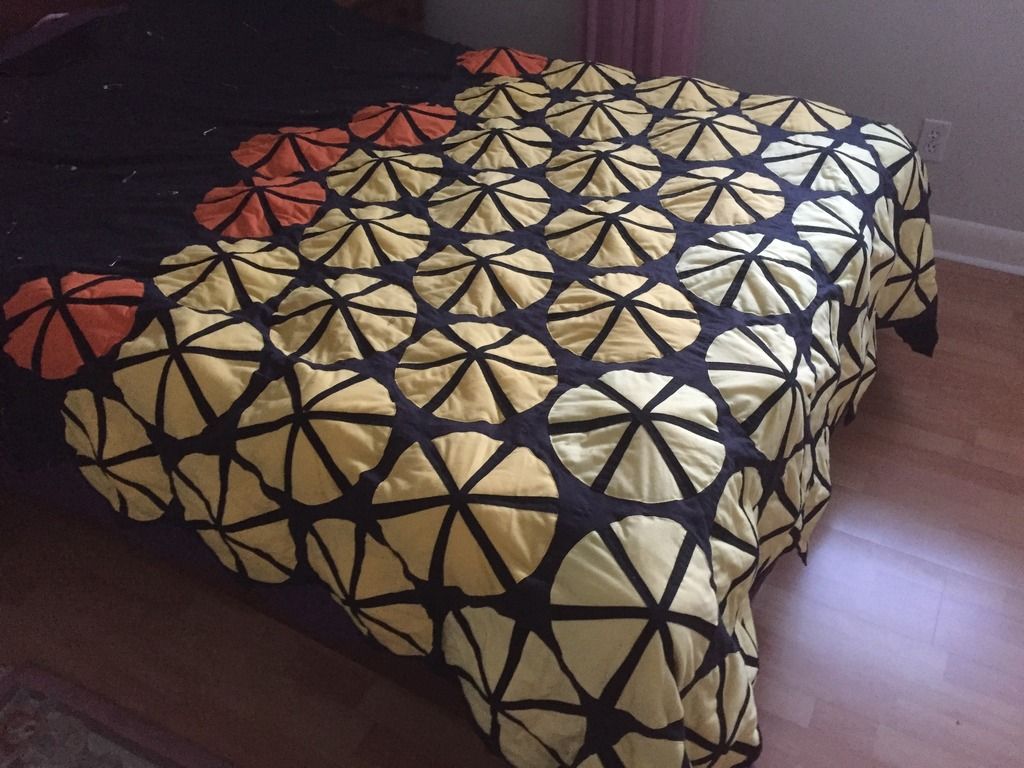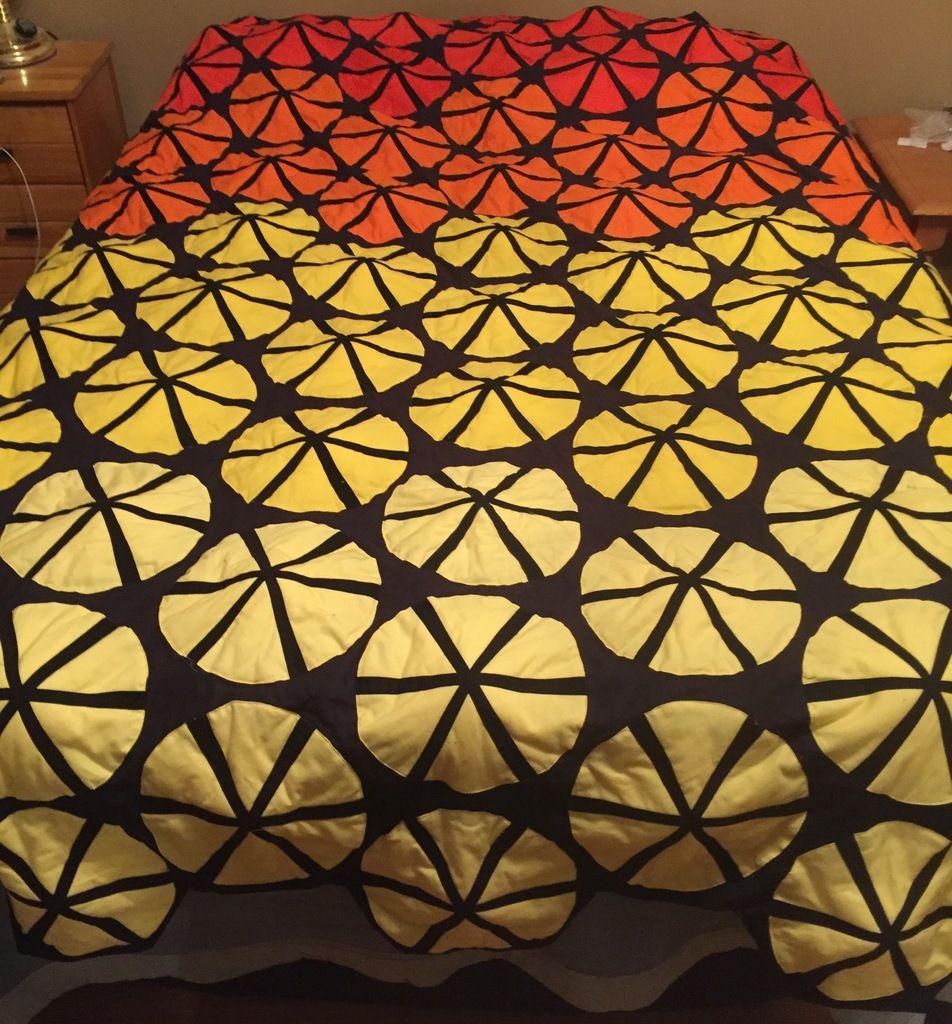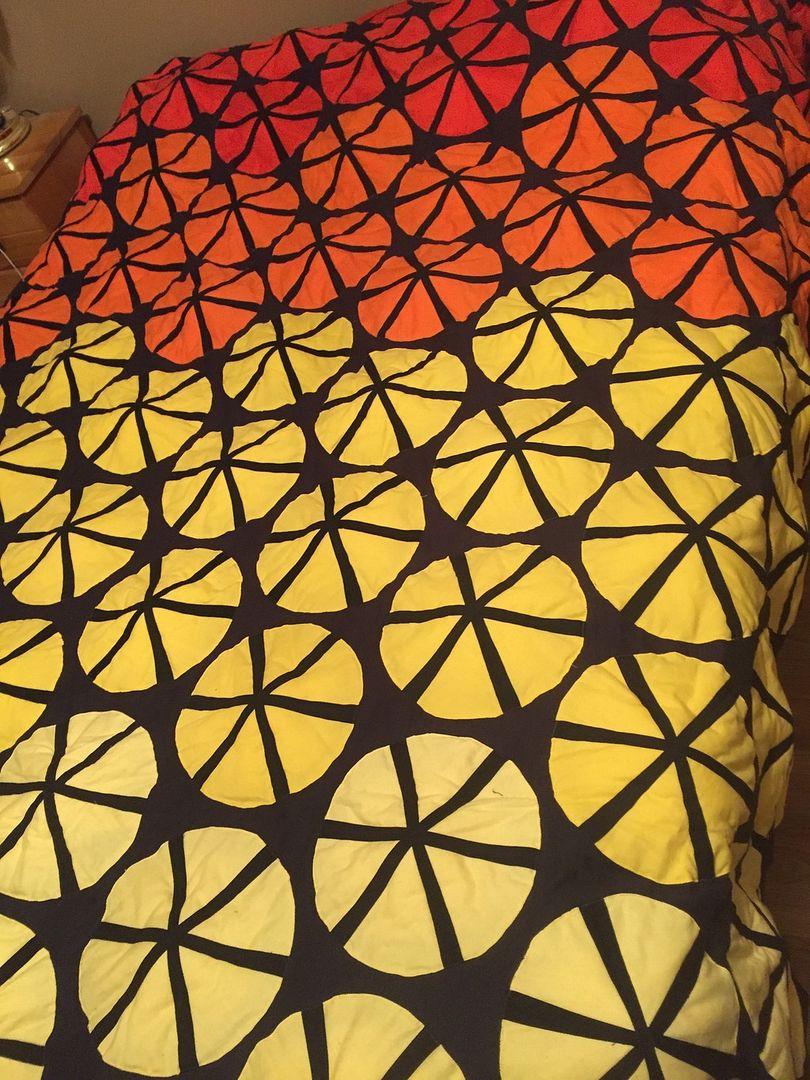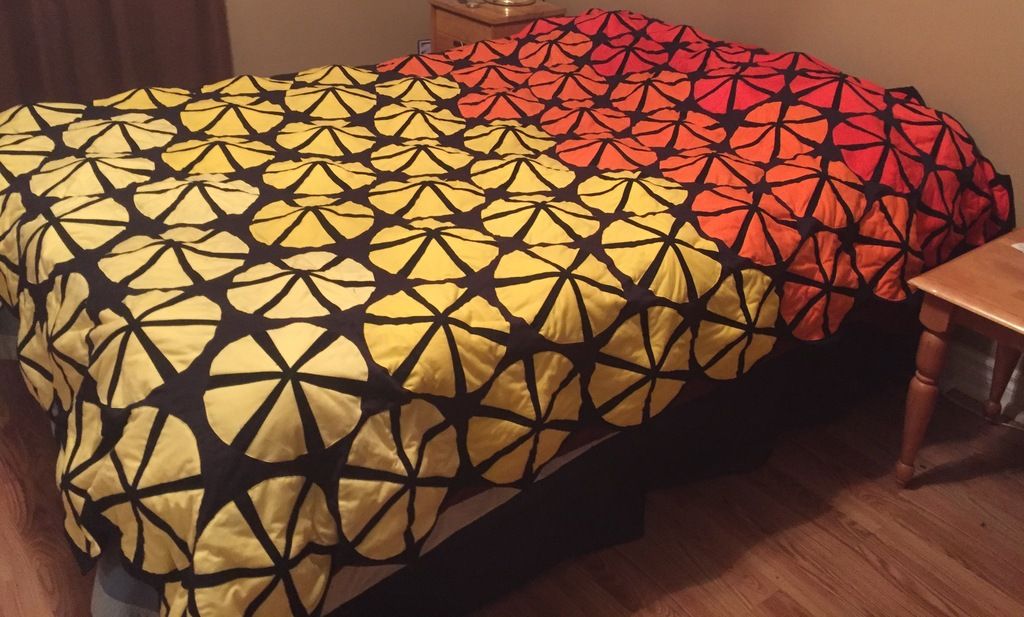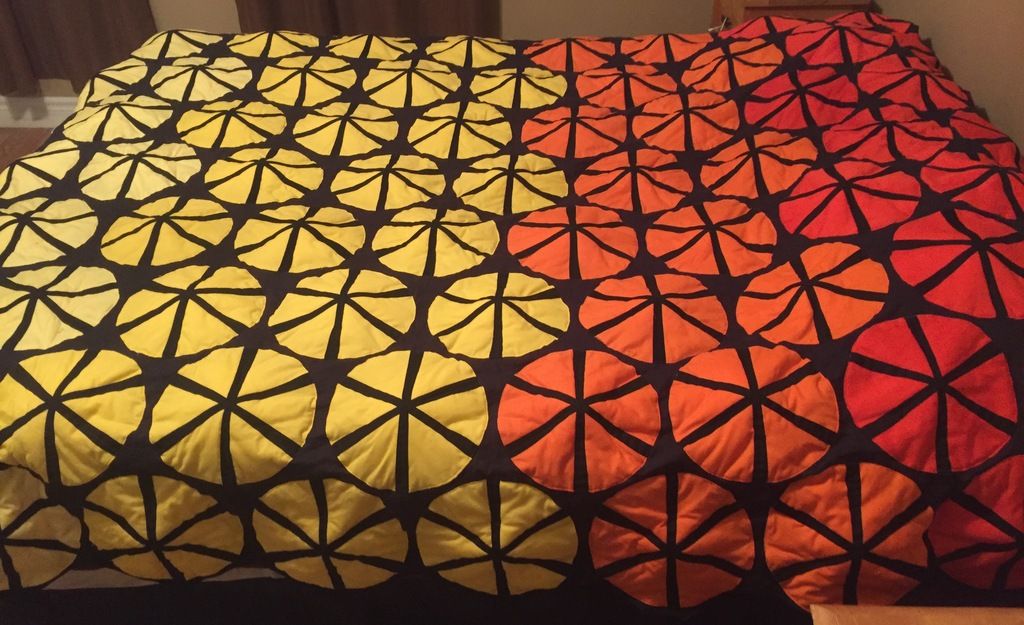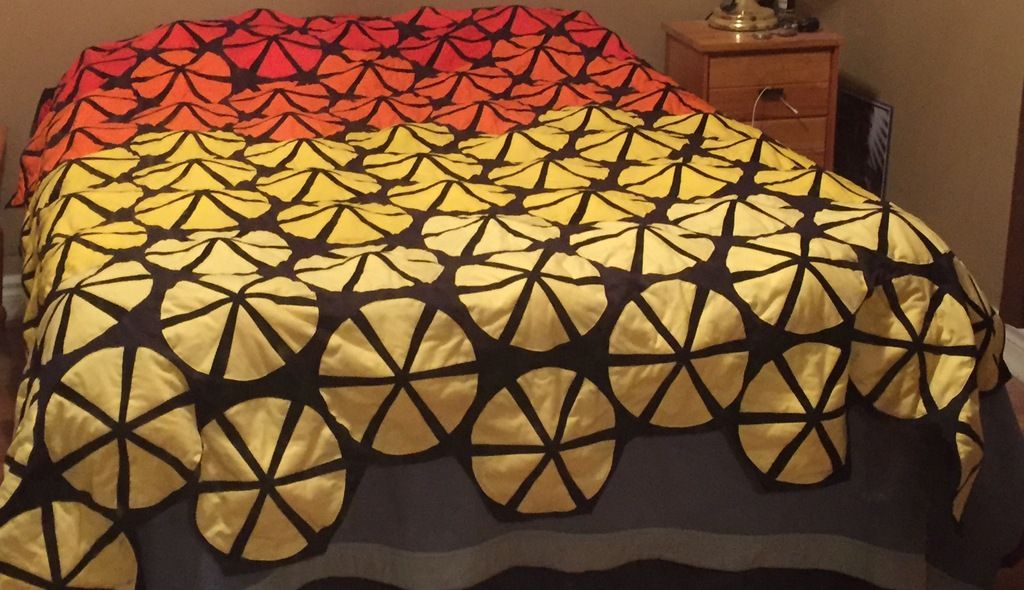You are using an out of date browser. It may not display this or other websites correctly.
You should upgrade or use an alternative browser.
You should upgrade or use an alternative browser.
A Clockwork Orange - bedding?
- Thread starter Patattack
- Start date
Another thread that slipped under my radar 
Fantastic work Paul !
:thumbsup
Fantastic work Paul !
:thumbsup
Paulreeddrz
New Member
Latest attempt, tried to make the light too.

- - - Updated - - -


- - - Updated - - -

Paulreeddrz
New Member
It does a lil but as previously mentioned its prob gonna take a neoprene material to get the right effect.
Paulreeddrz
New Member
Thanks for the nice comments!
I've just finished the first quarter of my own version of this quilt. I've been working on it on and off over the last few months, and some of the information I got from earlier posts here was super helpful, so I thought I would contribute what developed from that.

I'm a fine art student vaguely specialising in textile design, with a view to work in prop and costume for film, so this has really been a side project for me outside of studies to go into the portfolio. Because of that, I've been trying to make it as screen-accurate as I could. It was based mostly on the images found on this thread (you guys are all great!) and some maths to get the various dimensions and the slope of the cone right.
Most of my close up detail was based on one image in particular posted earlier, and I'll explain that before I show any close-ups of my own. Hem lines can clearly be seen between each segment, as well as around the orange triangles, most obviously at the base. I highlighted this in yellow underneath, for comparison. Very faintly, you can see the edges of the orange aren't clean - there is some fraying. I've circled where this is clearest in blue.

Because of this, I have tediously sat and cut out hundreds of reinforced black triangles, as well as hundreds of rounded orange ones with no seam allowance. I'm aware Neoprene was mentioned earlier on, but I'm not wholly convinced by that. Firstly, the cost of that would be immense on a film which had a relatively small budget, especially to spend on one prop, considering too the tools that would be needed to heat seal it etc. Secondly, the fabric in the image simply doesnt look like neoprene. Neoprene is much much thicker and spongier, it wouldn't behave in that way, with visible bumps and wrinkles and shallow seam folds. I could well be wrong, and I welcome anybody to conjecture as such, but I have some modern neoprene scraps I'd be willing to mock up samples with to demonstrate my reasoning. The logical selection both for them at the time and for me now based on these images is simple quilting cotton. It's pretty cheap (mine is £7.99/metre), comes in every colour under the sun, it's thin and easy to cut/sew and behaves like the fabric shown up there, and requires no special equipment to work with. On this basis, I've done mine as such:


Excuse all the loose threads, I've not had a chance to go round and trim them all up, especially the frayed ones from sewing. I'm not sure these were the best example sections, but oh well. You can see the pointed shape, and how I've gone around the inside edges of the triangles. I feel as though I should have stuffed them more, I only used one layer of the thickest wadding I could find, and it gets squished down quite a bit inside the shapes. Also I'm fairly proud to say, the 'cones' invert in the same way they do in the film, when pressed down on!
The colours don't show up in these photos as well as they do in real life which is a shame. I'll post more pictures around the halfway mark, I already have most of the next shade of orange cut out...

I'm a fine art student vaguely specialising in textile design, with a view to work in prop and costume for film, so this has really been a side project for me outside of studies to go into the portfolio. Because of that, I've been trying to make it as screen-accurate as I could. It was based mostly on the images found on this thread (you guys are all great!) and some maths to get the various dimensions and the slope of the cone right.
Most of my close up detail was based on one image in particular posted earlier, and I'll explain that before I show any close-ups of my own. Hem lines can clearly be seen between each segment, as well as around the orange triangles, most obviously at the base. I highlighted this in yellow underneath, for comparison. Very faintly, you can see the edges of the orange aren't clean - there is some fraying. I've circled where this is clearest in blue.

Because of this, I have tediously sat and cut out hundreds of reinforced black triangles, as well as hundreds of rounded orange ones with no seam allowance. I'm aware Neoprene was mentioned earlier on, but I'm not wholly convinced by that. Firstly, the cost of that would be immense on a film which had a relatively small budget, especially to spend on one prop, considering too the tools that would be needed to heat seal it etc. Secondly, the fabric in the image simply doesnt look like neoprene. Neoprene is much much thicker and spongier, it wouldn't behave in that way, with visible bumps and wrinkles and shallow seam folds. I could well be wrong, and I welcome anybody to conjecture as such, but I have some modern neoprene scraps I'd be willing to mock up samples with to demonstrate my reasoning. The logical selection both for them at the time and for me now based on these images is simple quilting cotton. It's pretty cheap (mine is £7.99/metre), comes in every colour under the sun, it's thin and easy to cut/sew and behaves like the fabric shown up there, and requires no special equipment to work with. On this basis, I've done mine as such:


Excuse all the loose threads, I've not had a chance to go round and trim them all up, especially the frayed ones from sewing. I'm not sure these were the best example sections, but oh well. You can see the pointed shape, and how I've gone around the inside edges of the triangles. I feel as though I should have stuffed them more, I only used one layer of the thickest wadding I could find, and it gets squished down quite a bit inside the shapes. Also I'm fairly proud to say, the 'cones' invert in the same way they do in the film, when pressed down on!
The colours don't show up in these photos as well as they do in real life which is a shame. I'll post more pictures around the halfway mark, I already have most of the next shade of orange cut out...
Last edited:
Yes, I noticed they seem to spread out too. The best I could think of was that instead of sewing them as cones, they were sewn more circularly, but if pulled up at the middle into a point it would hold under its own weight because of the stuffed segments. This would mean set people running on and re-fluffing them between each take though..
The fabric doesn't look too stretchy to me, but I suppose it's possible. It's true that stretch fabrics are pretty unforgiving. Perhaps if one wanted to use stretch, it could work better to interface it with a stretch interfacing. I used a regular interface for the back of the black cotton, as I wanted mine to have a tiny bit more structure (the crumpled tops on some of the pyramids just isn't my style. Plus, added durability). Perhaps without this, and with the more circular shape, it could easily be flattened out more for storage.
Fortunately the batting I used is about an inch and a half thick, but it's quite airy, so this means it compresses a lot at the edges of the seams. I don't have the quilt with me right now to take photos of some of the better filled triangles (I got pretty lazy about halfway through that lot, and for some reason chose to take photographs of the lazy part and not the good part. Oh well.)
I can't think of a fabric which it would be possible to mold in the way you're describing. I suppose some kind of thermoplastic fabric, but it would be quite tricky to get it to behave like that.
It looks to me like the black has wrinkled up around the edge of the orange along the sides, making whatever they've done there invisible. There are clearly seams along the bottom edges, but it's hard to see what's going on for the rest of it. I couldn't see a way to make a folded-under shape which could be easily (machine) sewn - I'm also kind of working on the basis that a busy production team would want a quicker option which looked good from a distance, as opposed to neatly slipstitching seams folded under (the only way to hide a seam like that) before stuffing and machine sewing the end. I suppose it's possible. To me that would be the only solution to a hidden seam which takes a folded-under form, and I've done plenty of slipstitching and it is both hell to do and very time consuming, even when you're skilled at it (I once had to slipstitch a whole jacket lining and it took HOURS; not recommended). I feel like they wouldn't be willing to reach to that though, especially as the original was destroyed shortly after. It's all very puzzling.
I think I may try mocking up a few pieces without the interfacing, just to see what happens. If it looks a lot better, I can fairly easily rip it off the quarter I've already done. Their fabric appears thinner than the ones I'm using, more like a shirt-weight cotton. Also, you can see I've been double stitching my orange seams, and with a bit more seam allowance than they have... I think this is paranoia more than anything!
The fabric doesn't look too stretchy to me, but I suppose it's possible. It's true that stretch fabrics are pretty unforgiving. Perhaps if one wanted to use stretch, it could work better to interface it with a stretch interfacing. I used a regular interface for the back of the black cotton, as I wanted mine to have a tiny bit more structure (the crumpled tops on some of the pyramids just isn't my style. Plus, added durability). Perhaps without this, and with the more circular shape, it could easily be flattened out more for storage.
Fortunately the batting I used is about an inch and a half thick, but it's quite airy, so this means it compresses a lot at the edges of the seams. I don't have the quilt with me right now to take photos of some of the better filled triangles (I got pretty lazy about halfway through that lot, and for some reason chose to take photographs of the lazy part and not the good part. Oh well.)
I can't think of a fabric which it would be possible to mold in the way you're describing. I suppose some kind of thermoplastic fabric, but it would be quite tricky to get it to behave like that.
It looks to me like the black has wrinkled up around the edge of the orange along the sides, making whatever they've done there invisible. There are clearly seams along the bottom edges, but it's hard to see what's going on for the rest of it. I couldn't see a way to make a folded-under shape which could be easily (machine) sewn - I'm also kind of working on the basis that a busy production team would want a quicker option which looked good from a distance, as opposed to neatly slipstitching seams folded under (the only way to hide a seam like that) before stuffing and machine sewing the end. I suppose it's possible. To me that would be the only solution to a hidden seam which takes a folded-under form, and I've done plenty of slipstitching and it is both hell to do and very time consuming, even when you're skilled at it (I once had to slipstitch a whole jacket lining and it took HOURS; not recommended). I feel like they wouldn't be willing to reach to that though, especially as the original was destroyed shortly after. It's all very puzzling.
I think I may try mocking up a few pieces without the interfacing, just to see what happens. If it looks a lot better, I can fairly easily rip it off the quarter I've already done. Their fabric appears thinner than the ones I'm using, more like a shirt-weight cotton. Also, you can see I've been double stitching my orange seams, and with a bit more seam allowance than they have... I think this is paranoia more than anything!
Last edited:
Yes, I suppose that's reasonable. The only thing for me that it keeps coming back to is the behaviour of the fabric; the surface looks too malleable to me, especially at the top and bottom of the orange where it wrinkles. That and I keep remembering watching some documentary where they talked about how the budget for the film was cripplingly limited. I don't know, I guess the only way to ever definitely answer these issues is with somebody who was on the team.
Definitely gluing would be an easier alternative to slipstitching in that situation. What do you mean about having to puff them up?
Definitely gluing would be an easier alternative to slipstitching in that situation. What do you mean about having to puff them up?
Cool, I'll try to get some this weekend. This lady nailed the pattern, IMO. The construction of the cones are a little different but with no original and very few images to reference, I support there is going to have to be some creative variations. Especially if you don't want to take years to actually get it done.
Last edited:
Similar threads
- Replies
- 19
- Views
- 3,281
- Replies
- 9
- Views
- 2,714
- Replies
- 9
- Views
- 3,767

